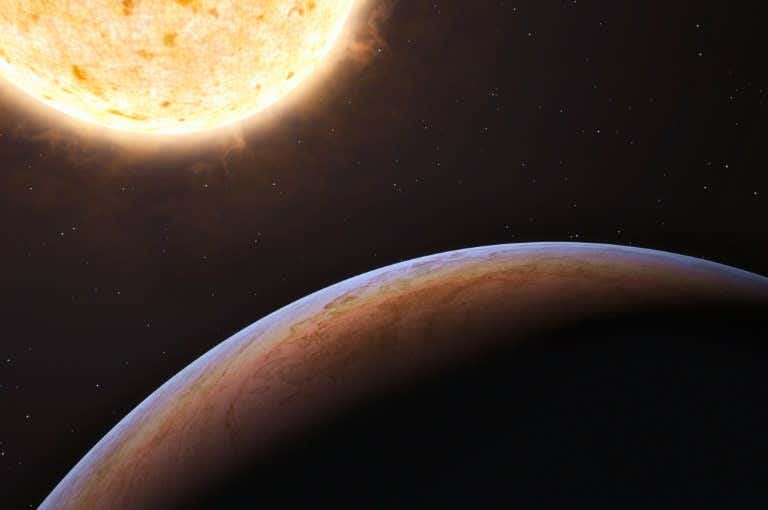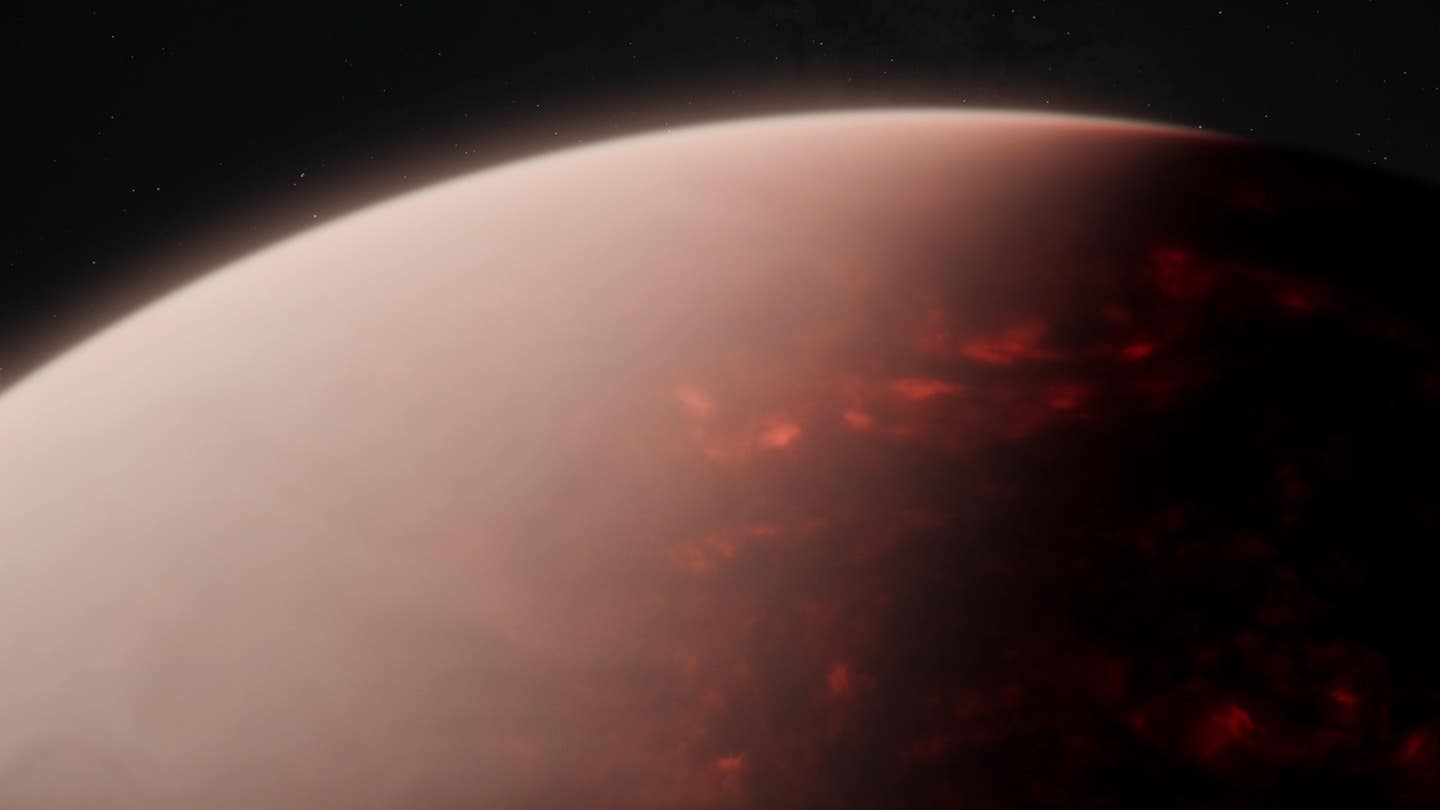Giant planet found orbiting tiny star challenges theories on planetary formation
A giant planet orbiting a tiny star challenges long-held planet formation theories and cool exoplanet atmospheres.

An artist’s illustration of an exoplanet and its star. (CREDIT: HO)
A recent astronomical discovery has shaken long-held beliefs about how planets form. For decades, scientists thought that stars much smaller than our Sun couldn't form giant planets. That theory just took a major hit. A gas giant has been found orbiting one of the smallest stars known to host such a planet—a low-mass red dwarf called TOI-6894.
This tiny star, only about 20% the mass of our Sun, was never expected to harbor a planet as large as TOI-6894b. Yet a team led by Dr. Edward Bryant, an astrophysicist who worked at the University of Warwick and UCL’s Mullard Space Science Laboratory, has confirmed just that.
A planet where it shouldn’t be
TOI-6894b is a gas giant, similar in size to Saturn but with about half its mass. It’s made mostly of hydrogen and helium and has a radius of about 0.855 times that of Jupiter. The planet’s mass is about 0.168 times Jupiter’s, or roughly 53 Earth masses. Despite this, it likely contains around 12 Earth masses worth of heavier elements—what scientists refer to as "metals."
Most planet formation models argue that stars with low mass like TOI-6894 don’t have enough material in their surrounding discs to form giants. These discs—made up of gas and dust—are the birthplace of planets. The bigger the star, the more massive the disc, and the more material there is to create large planets. But TOI-6894b challenges all of that.
“This discovery will be a cornerstone for understanding the extremes of giant planet formation,” said Bryant. “I originally searched through TESS observations of more than 91,000 low-mass red-dwarf stars looking for giant planets. Then, using one of the world’s largest telescopes, ESO’s VLT, I discovered TOI-6894b.”
Why this planet matters
Most stars in our galaxy are red dwarfs. They’re cool, dim, and small—just like TOI-6894. Scientists believed these stars couldn’t support large planets. That’s why TOI-6894b is such a game-changer.
Related Stories
“Most stars in our Galaxy are actually small stars exactly like this,” said Dr. Daniel Bayliss from the University of Warwick. “So, the fact that this star hosts a giant planet has big implications for the total number of giant planets we estimate exist in our Galaxy.”
Current theories suggest that stars this small lack enough building blocks in their protoplanetary discs to form massive cores. Without a big enough core, the process called runaway gas accretion—where a growing planet pulls in vast amounts of gas to become a gas giant—can’t happen. But here we are, staring at a planet that seems to defy that rule.
Dr. Vincent Van Eylen from UCL’s Mullard Space Science Laboratory put it plainly: “It’s an intriguing discovery. We don’t really understand how a star with so little mass can form such a massive planet!”
Theories under pressure
One of the main ideas for how gas giants form is called core accretion. A small planet core forms first, then gathers gas from the disc. When the core becomes massive enough, it pulls gas in rapidly, growing into a giant. But TOI-6894b may have formed in a different way.
“Given the mass of the planet, TOI-6894b could have formed through an intermediate core-accretion process,” explained Bryant. In this model, the planet slowly gathers gas without ever reaching the runaway stage.
Another idea involves a type of instability in the disc itself. Sometimes, a disc can collapse under its own weight, fragmenting into clumps that become planets. These gravitationally unstable discs are rare and not well understood.
Still, neither theory fully explains TOI-6894b. Its formation remains a mystery.
A cool atmosphere worth watching
What makes TOI-6894b even more exciting is what it can teach us about planetary atmospheres. Most gas giants found outside our solar system are hot—often with temperatures between 1,000 and 2,000 Kelvin. TOI-6894b is much cooler, around 420 Kelvin. That’s just under 300°F—hot, but far cooler than most gas giants.
Because of this, its atmosphere is rich with scientific potential. The planet’s deep transits—where it passes in front of its star—make it easier to study from Earth. When a planet transits its star, some of the starlight filters through its atmosphere. That light can be analyzed to reveal what gases are present.
Professor Amaury Triaud of the University of Birmingham said TOI-6894b could be the first exoplanet to show clear signs of methane and possibly ammonia. “Based on the stellar irradiation of TOI-6894b, we expect the atmosphere is dominated by methane chemistry, which is exceedingly rare to identify. Temperatures are low enough that atmospheric observations could even show us ammonia,” he explained.
If ammonia is found, it would be the first time it’s been observed in the atmosphere of a planet beyond our solar system. This makes TOI-6894b a prime candidate for future atmospheric studies.
The James Webb Space Telescope is already set to observe the planet within the next year. Those observations may help scientists figure out whether this planet formed from slow gas accumulation or from a collapsing disc.
A window into the unknown
The work behind this discovery was the result of years of effort by an international team. Dr. Andrés Jordán, a co-author and professor at Adolfo Ibáñez University in Chile, emphasized the long-term value of this research.
“This system provides a new challenge for models of planet formation,” said Jordán. “It offers a very interesting target for follow-up observations to characterize its atmosphere. This discovery is the result of a systematic program we have been carrying out for several years from Chile and the UK.”
The study opens up new questions about the number of gas giants in the galaxy. If a star as small as TOI-6894 can host such a large planet, then many other red dwarfs might as well. This could dramatically change our understanding of how common giant planets really are.
Bryant summed it up well: “We did not expect planets like TOI-6894b to be able to form around stars this low-mass.”
Now, with one of the smallest stars ever found to host a gas giant, scientists are rewriting the rules of planet formation—and watching the skies for what might come next.
Note: The article above provided above by The Brighter Side of News.
Like these kind of feel good stories? Get The Brighter Side of News' newsletter.



